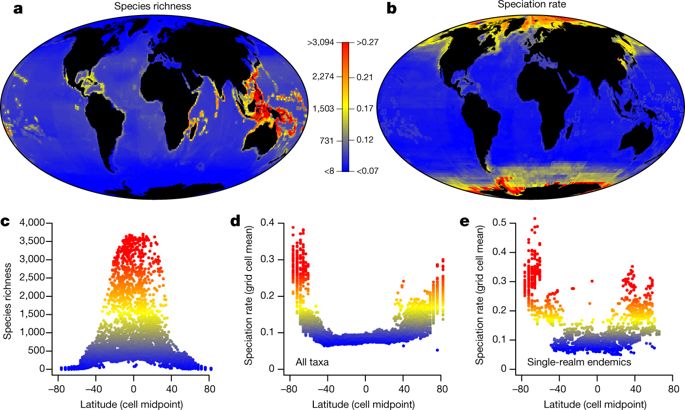Our official English website, www.x-mol.net, welcomes your feedback! (Note: you will need to create a separate account there.)
An inverse latitudinal gradient in speciation rate for marine fishes
Nature ( IF 64.8 ) Pub Date : 2018-07-01 , DOI: 10.1038/s41586-018-0273-1 Daniel L. Rabosky , Jonathan Chang , Pascal O. Title , Peter F. Cowman , Lauren Sallan , Matt Friedman , Kristin Kaschner , Cristina Garilao , Thomas J. Near , Marta Coll , Michael E. Alfaro
Nature ( IF 64.8 ) Pub Date : 2018-07-01 , DOI: 10.1038/s41586-018-0273-1 Daniel L. Rabosky , Jonathan Chang , Pascal O. Title , Peter F. Cowman , Lauren Sallan , Matt Friedman , Kristin Kaschner , Cristina Garilao , Thomas J. Near , Marta Coll , Michael E. Alfaro

|
Far more species of organisms are found in the tropics than in temperate and polar regions, but the evolutionary and ecological causes of this pattern remain controversial1,2. Tropical marine fish communities are much more diverse than cold-water fish communities found at higher latitudes3,4, and several explanations for this latitudinal diversity gradient propose that warm reef environments serve as evolutionary ‘hotspots’ for species formation5–8. Here we test the relationship between latitude, species richness and speciation rate across marine fishes. We assembled a time-calibrated phylogeny of all ray-finned fishes (31,526 tips, of which 11,638 had genetic data) and used this framework to describe the spatial dynamics of speciation in the marine realm. We show that the fastest rates of speciation occur in species-poor regions outside the tropics, and that high-latitude fish lineages form new species at much faster rates than their tropical counterparts. High rates of speciation occur in geographical regions that are characterized by low surface temperatures and high endemism. Our results reject a broad class of mechanisms under which the tropics serve as an evolutionary cradle for marine fish diversity and raise new questions about why the coldest oceans on Earth are present-day hotspots of species formation.Contrary to previous hypotheses, high-latitude fish lineages form new species at much faster rates than their tropical counterparts especially in geographical regions that are characterized by low surface temperatures and high endemism.
中文翻译:

海洋鱼类物种形成率的逆纬度梯度
在热带地区发现的生物种类远多于温带和极地地区,但这种模式的进化和生态原因仍然存在争议1,2。热带海洋鱼类群落比在高纬度地区发现的冷水鱼类群落更加多样化 3,4,对这种纬度多样性梯度的几种解释表明,温暖的珊瑚礁环境是物种形成的进化“热点”5-8。在这里,我们测试了海洋鱼类的纬度、物种丰富度和物种形成率之间的关系。我们组装了所有带鳍鱼类的时间校准系统发育(31,526 个尖端,其中 11,638 个具有遗传数据)并使用该框架来描述海洋领域物种形成的空间动态。我们表明,最快的物种形成速度发生在热带以外物种贫乏的地区,并且高纬度鱼类谱系形成新物种的速度比热带鱼类谱系快得多。高物种形成发生在以低地表温度和高特有性为特征的地理区域。我们的研究结果否定了热带作为海洋鱼类多样性进化摇篮的一大类机制,并提出了新的问题,即为什么地球上最冷的海洋是当今物种形成的热点。与之前的假设相反,高纬度鱼类谱系形成新物种的速度比热带物种快得多,特别是在以低地表温度和高度特有性为特征的地理区域。并且高纬度鱼类谱系形成新物种的速度比热带鱼类快得多。高物种形成发生在以低地表温度和高特有性为特征的地理区域。我们的研究结果否定了热带作为海洋鱼类多样性进化摇篮的一大类机制,并提出了新的问题,即为什么地球上最冷的海洋是当今物种形成的热点。与之前的假设相反,高纬度鱼类谱系形成新物种的速度比热带物种快得多,特别是在以低地表温度和高度特有性为特征的地理区域。并且高纬度鱼类谱系形成新物种的速度比热带鱼类快得多。高物种形成发生在以低地表温度和高特有性为特征的地理区域。我们的研究结果否定了热带作为海洋鱼类多样性进化摇篮的一大类机制,并提出了新的问题,即为什么地球上最冷的海洋是当今物种形成的热点。与之前的假设相反,高纬度鱼类谱系形成新物种的速度比热带物种快得多,特别是在以低地表温度和高度特有性为特征的地理区域。高物种形成发生在以低地表温度和高特有性为特征的地理区域。我们的研究结果否定了热带作为海洋鱼类多样性进化摇篮的一大类机制,并提出了新的问题,即为什么地球上最冷的海洋是当今物种形成的热点。与之前的假设相反,高纬度鱼类谱系形成新物种的速度比热带物种快得多,特别是在以低地表温度和高度特有性为特征的地理区域。高物种形成发生在以低地表温度和高特有性为特征的地理区域。我们的研究结果否定了热带作为海洋鱼类多样性进化摇篮的一大类机制,并提出了新的问题,即为什么地球上最冷的海洋是当今物种形成的热点。与之前的假设相反,高纬度鱼类谱系形成新物种的速度比热带物种快得多,特别是在以低地表温度和高度特有性为特征的地理区域。
更新日期:2018-07-01
中文翻译:

海洋鱼类物种形成率的逆纬度梯度
在热带地区发现的生物种类远多于温带和极地地区,但这种模式的进化和生态原因仍然存在争议1,2。热带海洋鱼类群落比在高纬度地区发现的冷水鱼类群落更加多样化 3,4,对这种纬度多样性梯度的几种解释表明,温暖的珊瑚礁环境是物种形成的进化“热点”5-8。在这里,我们测试了海洋鱼类的纬度、物种丰富度和物种形成率之间的关系。我们组装了所有带鳍鱼类的时间校准系统发育(31,526 个尖端,其中 11,638 个具有遗传数据)并使用该框架来描述海洋领域物种形成的空间动态。我们表明,最快的物种形成速度发生在热带以外物种贫乏的地区,并且高纬度鱼类谱系形成新物种的速度比热带鱼类谱系快得多。高物种形成发生在以低地表温度和高特有性为特征的地理区域。我们的研究结果否定了热带作为海洋鱼类多样性进化摇篮的一大类机制,并提出了新的问题,即为什么地球上最冷的海洋是当今物种形成的热点。与之前的假设相反,高纬度鱼类谱系形成新物种的速度比热带物种快得多,特别是在以低地表温度和高度特有性为特征的地理区域。并且高纬度鱼类谱系形成新物种的速度比热带鱼类快得多。高物种形成发生在以低地表温度和高特有性为特征的地理区域。我们的研究结果否定了热带作为海洋鱼类多样性进化摇篮的一大类机制,并提出了新的问题,即为什么地球上最冷的海洋是当今物种形成的热点。与之前的假设相反,高纬度鱼类谱系形成新物种的速度比热带物种快得多,特别是在以低地表温度和高度特有性为特征的地理区域。并且高纬度鱼类谱系形成新物种的速度比热带鱼类快得多。高物种形成发生在以低地表温度和高特有性为特征的地理区域。我们的研究结果否定了热带作为海洋鱼类多样性进化摇篮的一大类机制,并提出了新的问题,即为什么地球上最冷的海洋是当今物种形成的热点。与之前的假设相反,高纬度鱼类谱系形成新物种的速度比热带物种快得多,特别是在以低地表温度和高度特有性为特征的地理区域。高物种形成发生在以低地表温度和高特有性为特征的地理区域。我们的研究结果否定了热带作为海洋鱼类多样性进化摇篮的一大类机制,并提出了新的问题,即为什么地球上最冷的海洋是当今物种形成的热点。与之前的假设相反,高纬度鱼类谱系形成新物种的速度比热带物种快得多,特别是在以低地表温度和高度特有性为特征的地理区域。高物种形成发生在以低地表温度和高特有性为特征的地理区域。我们的研究结果否定了热带作为海洋鱼类多样性进化摇篮的一大类机制,并提出了新的问题,即为什么地球上最冷的海洋是当今物种形成的热点。与之前的假设相反,高纬度鱼类谱系形成新物种的速度比热带物种快得多,特别是在以低地表温度和高度特有性为特征的地理区域。



























 京公网安备 11010802027423号
京公网安备 11010802027423号